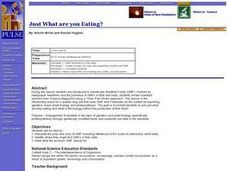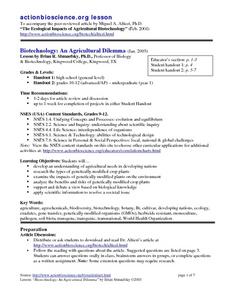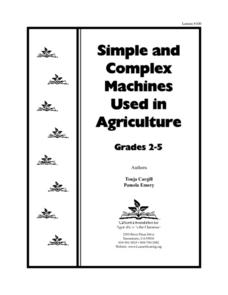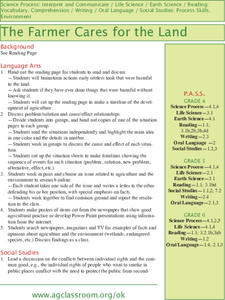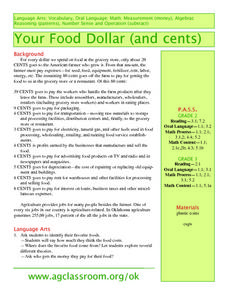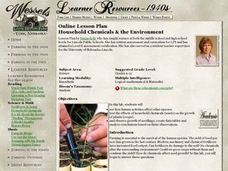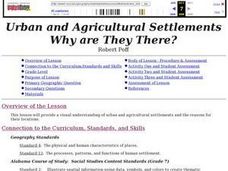Curated OER
Time Line of the Land
Students use the internet to discover how agriculture has changed over time. In groups, they research any terms they are unfamiliar with and present their findings to the class. They are assigned one section of the timeline and...
Curated OER
Wheat: From Field to Oven
How does wheat go from the seed to the table? While focusing on main ideas and supporting statements, class members read an excerpt about wheat production and complete a worksheet. The end goal is a display that shows the different...
Curated OER
What's Organic?
Young scholars define and discuss terms organic and synthetic, read article pertaining to organic agricultural practices in Oklahoma, complete worksheet, grow plants using both commercial and organic fertilizer, compare growth rates, and...
Curated OER
Identifying Reasons for World Trade
Students examine the advantages and disadvantages of world trade. They participate in a class discussion of international trade, read a handout about a specific country, and in small groups label a map with agricultural commodity...
Curated OER
Just What are you Eating?
Students identify and articulate pros and cons of genetically modified foods (GMF) including references to scale of controversy worldwide. Students then identify where they might find GMFs in their diets, read different opinion pieces on...
Curated OER
What is the Composition of Soil?
Students examine the different components that make up soil. Using data, they identify the components of soil in their local area and discover how scientists use the soil to see how it was formed. They also describe the soil forming...
Curated OER
Agriculture and Slavery
Students explore the importance of agriculture, especially tobacco farming, and the influence it had on slavery in the state of Virginia. Students establish the sequence of tobacco and slavery in the state.
Curated OER
Harvest Happenings
Students explore the history of agriculture and develop a personal connection to agriculture. Students investigate how farming practices have evolved through the years and create poetry relating to harvest.
Curated OER
Breeds of Cattle Internet Search
Students identify different breeds of cattle and select one breed to investigate further. They gather information online about breed's origin, physical characteristics, advantages, and disadvantages, and present their findings orally to...
Curated OER
Native Knowledge
Students investigate what type of climate and physical features certain Indigenous groups live in using an atlas and a provided worksheet. They then match the tribe and its location to the sustainable stategy employed in agricultural...
Curated OER
The Dust Bowl and the Ogallala Aquifer
Students research the characteristics of the Great Plains as an agricultural area. They examine farming techniques from the past and how those farming techniques are used today. They investigate the present uses of the Ogallala Aquifer.
Curated OER
Land Use in Australian Agriculture
Seventh graders research and map agricultural practices of Australia. They complete a worksheet about their research.
Curated OER
Introduction to Farming in the United States
Learners discuss basic foods and what constitutes a well-balanced meal. They identify four basic food groups, and identify food sources, such as farms.
Curated OER
GMOs: Should We Grow Them?
Students examine the ethics of biotechnology and genetically modifying various organisms. They complete various activities and labs on GMOs and then write a position paper regarding their individual opinions on the subject.
Curated OER
That Was Then, This Is Now
Students examine the price of food over time. They analyze charts, perform math operations and compare and contrast data about the price of food. They complete worksheets while interperting the charts.
Curated OER
Children in the Fields: The Life of the Hispanic Child Laborer During California's Agriculture Explosion
Fourth graders examine the agriculture explosion in California in the late 1800's to the early 1930's. They analyze primary source material putting themselves into the shoes of a child laborer. They also gain an understanding of...
Curated OER
Biotechnology: An Agricultural Dilemma
Students investigate the types of genetically modified crop plants there are and the benefits and risks of such plants. The agricultural needs in developing nations for this biological knowledge to resolve societal issues is also...
Curated OER
Simple and Complex Machines Used In Agriculture
Students explore agriculture and the current technologies and research that continue to make Earth a viable planet. This four lessons unit introduce students to simple machines and the concepts of force and friction through a variety of...
Curated OER
A Visit to Price Chopper
Students visit the grocery store to purchase items to make trail mix which are connected to Kansas agriculture. They problem solve to determine which products to buy, then create, advertise and sell the trail mix to the student body...
Curated OER
The Farmer Cares for the Land
Students identify cause and effect relationships in issues relating to agriculture and the environment.
Curated OER
Your Food Dollar (and Cents)
Young scholars examine where their food dollars go while recognizing coins and making change. They identify their favorite foods, receive one dollar, and take away amounts for each person involved in the production of their food dollar.
Curated OER
Household Chemicals & the Environment
High schoolers conduct a laboratory experiment designed to investigate the effects of chemicals, soil quality and pollution on seed growth and plant yield. They consider how best to maximize agriculture in the long term.
Curated OER
Growing Our Own Food: Sustainable Agriculture
Students identify the common food items in their community, plant a small garden and discuss how agriculture has helped growing nations.
Curated OER
Urban and Agricultural Settlements Why are They There?
Seventh graders identify types of human settlements, urban and agricultural, and determine geographic influence on why people settle where they did by use of maps and charts. They, in groups, identify the needs of a new settlement, which...






